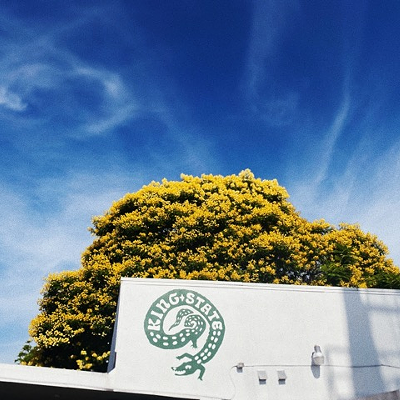
At first glance, she bears a striking resemblance to French actress Audrey Tautou of Amélie fame — so much so that I wonder if the photograph isn't a still from a film.
Something about it evokes the immediacy of cinema. Glints of silver leaf coating the image create a shimmering depth that borders on holographic. Standing before it, I feel as though I'm staring into a living film frame — or a tableau vivante. By comparison, other pictures hanging on the gallery walls seem safely entombed behind layers of mat and glass, but this one, covered only by a coat of clear, hard resin, suggests a doorway into another world.
Inside, the figure of the young woman stands stock still. Without suggestion of movement or speech, she nevertheless bears some message — a warning or a silent accusation, perhaps. Flecks of red visible through the cool silver at her neck imbue it with heat, life, and, inevitably, a hint of blood.
The haunting sense of mystery that surrounds the woman in the photo resonates in an exhibit at the Tampa Museum of Art that poses the question: What Does This Mean? (See review in this week's a&e section.) To stage this provocative inquiry, the exhibit draws from works in the museum's permanent collection that tell stories through a wide variety of imagery.
Collectively, the artworks tell another story: of a museum that interim director Ken Rollins said has been criticized at times for lacking clarity with regard to what it collects. Inspired by the exhibit, I visited the museum to find out how and why objects, like the mysterious photograph of the Amélie look-alike, make it into the permanent collection.
Misperceptions about what the TMA collects — and opinions about what it ought to — stem perhaps from the image people typically have of an art museum: marble-lined hallways, canvases by Renaissance and Impressionist masters, maybe a Rodin or two. Unlike the Museum of Fine Art in St. Petersburg, the Tampa museum lacks a permanent collection that spans the globe from ancient to modern times and covers many of the bases in between.
What it does have — and continues to supplement — is a collection strong in very specific fields: Greek and Roman antiquities, 20th century graphic art, contemporary studio glass, and post-1970 photography and new media works. Those areas of focus have a lot to do with the museum's history and its commitment to growing a "distinct and distinguished" collection rather than duplicating the efforts of nearby institutions, said Rollins.
The museum began its life as a community arts center in the 1970s, a heritage that inspired a longstanding engagement with contemporary art, said Elaine Gustafson, director of exhibitions and collections and curator of contemporary art. In the '80s, the Greek and Roman antiquities entered the collection as a combination gift and purchase from a single donor. Since then, new additions to the collection — typically 20 to 100 objects per year — trickle in, primarily as individual gifts.
Gustafson supplements those gifts, which constitute 80 to 90 percent of the collection, with purchases from a pair of endowment funds. Of the two, the larger Frank E. Duckwall Endowment, is earmarked exclusively for contemporary photography. Its $250,000 principle yields $10-$15,000 in interest annually for purchases — a sum that brought two new photographs into the collection last year.
Like any object that enters the permanent collection, pieces purchased with endowment funds must be vetted for qualifications that range from the obvious (authenticity and condition) to the slightly more subjective (aesthetic quality and pertinence to the collection) to the administrative.
Gustafson, who takes the first pass at those more subjective judgments by selecting and suggesting potential acquisitions, uses her limited purchasing power to fill gaps in the collection, she said. Each year, she looks for photographs that will complement and expand the existing collection, and that are at the forefront of creativity in their field. Recently, for example, she has sought out works that demonstrate innovative use of scale and materials, engaging visitors with the idea that photography has grown beyond the traditional image of the 8x10 framed picture. Last year, she tried something new. In conjunction with Arte 2005, a community-wide celebration of Latin American culture, Gustafson organized an exhibit of photographers from that part of the world and used it as a sounding board with visitors to decide on several potential new acquisitions. Adding Latin American photographers in particular to the collection seemed important to her, she said, because they were — at the time — underrepresented in the collection compared to their presence in contemporary art.
Pulling diverse works from such artists as Alfredo Jaar, Liliana Porter, Vik Muniz, Sebastião Salgado and Luis Gonzalez Palma — artists whose careers she had followed and who she felt would make good additions to the collection — she waited to see what visitors would say. Docents, the volunteers who lead tours and field visitor questions, served as her eyes and ears during the exhibit. They reported back on which images sparked visitor interest and conversations.
One photograph in particular by Palma, it seemed to visitors, told a haunting story about a mysterious young woman — but what that story was, they couldn't be sure. The woman's expression seemed to indicate a deep sadness; her surroundings provided no clue as to why she was there; and most unsettlingly, the pair of hands that clasped her waist seemed at first to be hers, then upon closer examination, to belong to a man. The title, translated into English as "The Opposite of the Surrender," only spawned more conjecture. Viewers wanted to know what it meant.
Another photograph, by Salgado, provoked a similar fascination. The dramatic image of workers scaling the steep sides of a gold mine — so many that they resembled a waterfall of bodies — caught the attention of visitors, who were also moved by its suggestion of social injustice.
After collecting the comments, Gustafson advanced works by the two artists as potential purchases. Following discussions with and approval from Rollins, she presented two to three different works by each artist to the museum's board of trustees. Palma's mysterious heroine won approval in one sitting, but the board deliberated over which size print of the Salgado to purchase. After seeing the original size and an enlarged version, they decided that the smaller one packed more visual punch.
Following the board's approval and release of the endowment funds, Gustafson bought both photographs from their galleries, paying $7,800 for the Palma and $5,500 for the Salgado. (As an institutional client, the museum received a 10 percent discount from the galleries, Gustafson said.)
Having entered the permanent collection of the Tampa Museum of Art, what's ahead for these photographs? Well, storage. Because works can only be displayed for a total of 12 weeks each year to maintain their physical condition, they spend a lot of time in dark, climate-controlled rooms.
But for now, while the current exhibit continues at the museum, enjoy a panoramic view of the permanent collection, including Palma's mysterious beauty.
Fall Arts 2006: Choose Me
- Intro
- choose me: tampa museum of art
- choose me: theater life
- choose me: the tampa review
- choose me: griz collective
- A Revolving Door
- choose me: the florida orchestra
- Keeping Tabs
What to Watch For















